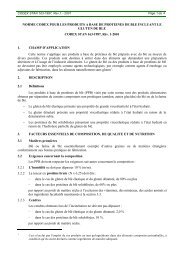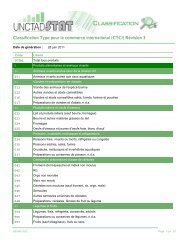issues and constraints related to the development of cashew nuts ...
issues and constraints related to the development of cashew nuts ...
issues and constraints related to the development of cashew nuts ...
Create successful ePaper yourself
Turn your PDF publications into a flip-book with our unique Google optimized e-Paper software.
7 Non-insect pestsIn Guinea <strong>and</strong> Guinea Bissau, squirrels were reported <strong>to</strong> be a pest, as <strong>the</strong>y cut <strong>the</strong> stems <strong>of</strong> young<strong>cashew</strong> plants.Birds or bats eating <strong>the</strong> apples <strong>and</strong> birds taking germinating seeds were also generally mentioned.Although not normally referred <strong>to</strong> as a pest, cattle were certainly causing many problems foryoung <strong>cashew</strong> plants <strong>and</strong> farmers frequently reported this. Disease <strong>constraints</strong>The two surveys were undertaken at <strong>the</strong> most critical time <strong>of</strong> year with regard <strong>to</strong> production <strong>of</strong><strong>cashew</strong>, i.e. at <strong>the</strong> time <strong>of</strong> flowering <strong>and</strong> nut setting. Obviously diseases could be prevalent a<strong>to</strong><strong>the</strong>r times <strong>of</strong> <strong>the</strong> year, for example during <strong>the</strong> rainy season, but are less likely <strong>to</strong> have a majorimpact on yield.AnthracnoseDamage symp<strong>to</strong>ms:The fungus Colle<strong>to</strong>trichum gleosporioides is <strong>the</strong> causal agent <strong>of</strong> anthracnosis, a disease found on<strong>cashew</strong> <strong>and</strong> common on o<strong>the</strong>r tropical fruit crops, e.g. mango, citrus, avocado, papaya etc. Blackor dark brown necrotic spots or lesions occur on leaves, apples <strong>and</strong> <strong>nuts</strong>. It is particularlyprevalent during <strong>the</strong> rainy season <strong>and</strong> can completely kill <strong>the</strong> first flush <strong>of</strong> new shoots <strong>and</strong> persist<strong>to</strong> kill varying amounts <strong>of</strong> later flushes as well. The severity <strong>of</strong> <strong>the</strong> disease varies from year <strong>to</strong>year <strong>and</strong> place <strong>to</strong> place depending on environmental conditions.Anthracnose is <strong>the</strong> major constraint <strong>to</strong> <strong>cashew</strong> production in Brazil. In <strong>the</strong> year 2000 it wasestimated that yields had been reduced by 40% by this disease. In South America, anthracnoseoccurs on both dwarf <strong>and</strong> tall trees. Copper sprays are used <strong>to</strong> control anthracnose on dwarveswith up <strong>to</strong> a maximum <strong>of</strong> 10 applications per season. Sanitation, <strong>the</strong> collecting up <strong>and</strong> burning <strong>of</strong>all old infected leaves, can help in reducing <strong>the</strong> level <strong>of</strong> inoculum <strong>the</strong> following year.Anthracnose can survive on <strong>the</strong> old leaves <strong>and</strong> in <strong>the</strong> soil.During <strong>the</strong> one-<strong>of</strong>f survey <strong>of</strong> West Africa conducted at <strong>the</strong> time <strong>of</strong> flowering/nut set in 2001, onlyvery minor amounts <strong>of</strong> what looked like “fully developed” anthracnose were found in GuineaBissau, Guinea <strong>and</strong> Cote d’Ivoire. In <strong>the</strong> production year 2001, in <strong>the</strong> areas visited in <strong>the</strong> fivecountries, anthracnose was <strong>of</strong> no economic importance. It should be noted, however, that thisdisease would be most prevalent during <strong>the</strong> rainy season. However, even if it was importantduring <strong>the</strong> rainy season, <strong>the</strong>re appeared <strong>to</strong> be very little carry over in<strong>to</strong> <strong>the</strong> dry season floweringperiod <strong>to</strong> attack panicles <strong>and</strong> developing fruits.Therefore, it was concluded that anthracnose had no effect, or had only a minor effect on yieldsin 2001 in <strong>the</strong> main <strong>cashew</strong> producing areas visited. The drier areas fur<strong>the</strong>r north, which was notvisited, would be even less likely <strong>to</strong> have anthracnose. However, <strong>the</strong> conclusion that anthracnosewas <strong>of</strong> minor economic importance, at least in 2001, is in marked contrast with <strong>the</strong> perceivedunderst<strong>and</strong>ing <strong>of</strong> <strong>the</strong> situation by people working in <strong>the</strong> countries concerned. From discussionswith various researchers, extension workers, as well as from literature <strong>and</strong> completedquestionnaires, it appeared that anthracnose was an economically significant constraint <strong>to</strong> <strong>cashew</strong>production in West Africa.


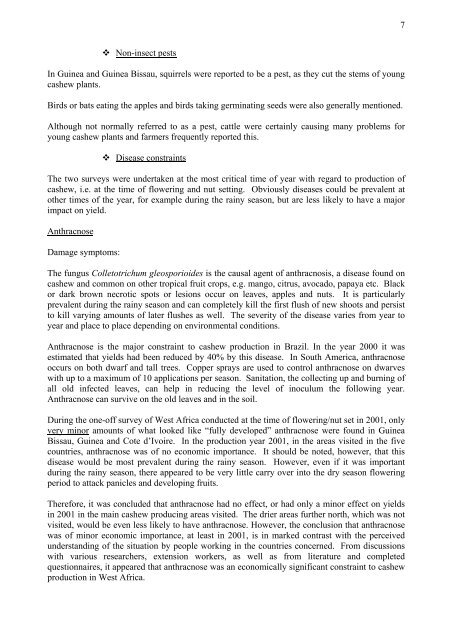
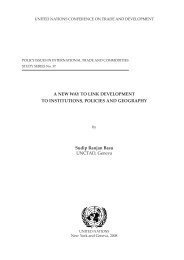

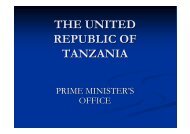
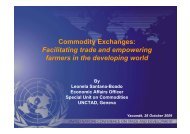
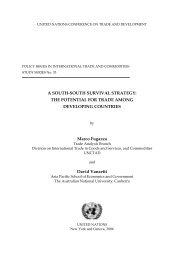
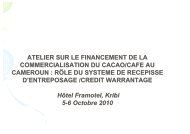
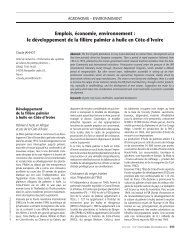
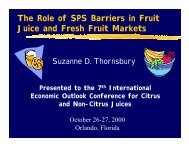
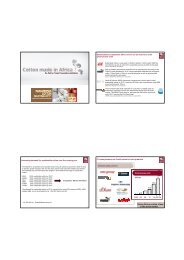
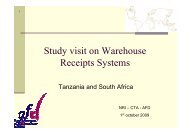
![Warehouse Receipt Systems: Legal Issues [PDF]](https://img.yumpu.com/43979338/1/190x134/warehouse-receipt-systems-legal-issues-pdf.jpg?quality=85)
